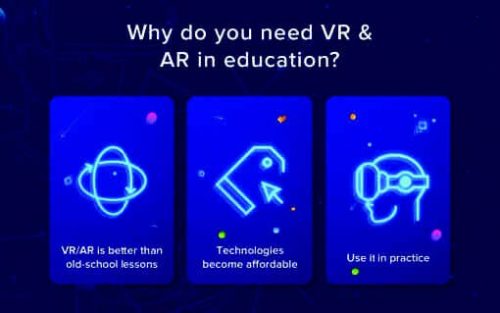From movie projectors to TVs laptops and gaming apps teachers have always experimented with new technology to augment classroom lessons and increase student engagement. Today two of these new technologies are especially exciting for educators virtual reality and augmented reality so what are they and how do they differ.
Virtual yet real – these two adjectives sound polar opposites, but they have revolutionized the way students learn nowadays. Education technology and ICT-based learning have changed the dynamics of classroom teaching, as it has become more interactive and experiential. Different technologies in education have elevated the level in which students grasp a concept. Virtual reality (VR) and augmented reality (AR) are a few of them.
Virtual reality or VR is immersive with the help of some specialized equipment you’re interacting with a computer-generated environment. Augmented reality or AR is non immersive meaning you’re superimposing sounds images and text.
As a kid, most of us must have thought of going and catching a glimpse of the amazing Northern Lights or for that matter, understand the scientific phenomena behind it. What if we can get the same experience and knowledge about it right here, right now, without having to travel all the way to Norway. Yes! This is very much possible with the help of virtual reality, which helps create a virtual environment, offering a realistic feel of being in the actual environment.
Immersive Experience Through VR
Imagine yourself sitting in a classroom, and the teacher explaining the laws of friction. It can be difficult for you to grasp the concept without any visuals. By deploying virtual reality, you can easily understand abstract concepts. For instance, without travelling to the Sydney Opera House in Australia, you can have a 360-degree view of one of the most famous performing arts venues.

Virtual reality gives a very engaging experience, and when rightly used in education, it can help in increasing the attention span of students. It is a three-dimensional world where a user can manipulate and explore while feeling as if he were in that world. In a virtual reality environment, a learner experiences complete immersion with the feeling of being inside and a part of that world and all sensory organs are utilized. The 360-degree view makes the graphics more Imagine yourself sitting in a classroom, and the teacher compelling and caters to better understanding.
Blend Digital Content with Classroom Teaching
Digital content empowers teachers. The right blend of digital content in the lesson plans ensures holistic teaching. The teaching-learning process had become student-centric. The use of technology always improves the engagement and retention level of the learners. When students can simulate the environment, they learn by doing.

Enhanced Experience Through AR
Augmented reality adds on to another dimension of learning as it allows us to augment any object in space, explore and interact with it. AR can be used in classrooms to change the way students interact with the real world. AR replaces printed textbooks, bulky models, and paper charts, offering portable and less expensive learning materials. No special equipment is required. As a result, education becomes more accessible. AR in the education sector in India has recently come into existence, yet it has begun to show its possible future potentialities.

A preschool curriculum can have augmented books and worksheets having graphics superimposed on them to provide a superb visual experience. Froggipedia, the iPad App of the Year across the world, is an augmented reality app that lets a user enlarge a frog in any ground plane and explore its different parts, allowing the user to dissect the amphibian virtually. There is an AR app for books where conceptual images can be mapped with the interactive models/activities and videos. The app initialises the augmentation when the camera of the device scans the image in the book. The 3D model gets augmented on top of the textbook, where the user can interact and have real-time experience, making learning interactive, fun and effortless.
VR and AR stimulate student interests deepen understanding and engage both the left critical and right creative sides of the brain for maximum innovation. With VR and AR students get to experience the benefits of holistic thinking as they craft their digital stories and to and once enable VR and AR so students can create and collaborate in 3D away from their desks throughout the school day. Students can begin using AR and VR as early as elementary school in fact many student gamers take to it instantly just imagine what children could do with creative tools.
Have seen tons of articles like this one, but would love to see practical examples, and get an idea how much this new technique is already embedded in clat-ssroom training. Sorry to sound critical, but to me it looks like budget, fear of innovative methods both for trainers and trainees are a big treshold. Why is no one writing about the ‘real’ world instead of theoretical articles?
You must be logged in to post a comment.









